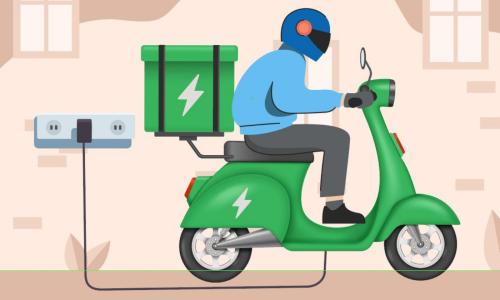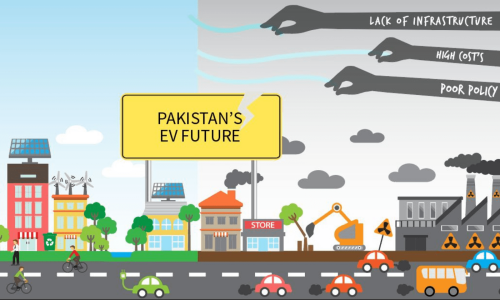Boarding the Electric Bus
Travelling in a diesel hybrid electric bus on Karachi’s Red Line is a calm and comfortable experience. Unlike older diesel-run buses, passengers alight instead of making super-human efforts to hoist themselves on board. In fact, boarding one of the older buses was quite a feat, as passengers had to run in the middle of the road to catch one, and stepping down required taking one’s life in one’s hands to try to avoid being hit by oncoming traffic.
In fact, the introduction of Chinese electric and hybrid buses is signalling a sort of travelling revolution by offering passengers a safer and more comfortable ride. The only drawback with the new EV and hybrid vehicles is their limited seat capacity, which is insufficient during peak hours. For context, the old buses had 35 (albeit uncomfortable) seats, compared to the 20 to 30 seats available in hybrid and EV vehicles. In this respect, it is estimated that Karachi alone requires at least 8,000 to 10,000 of these buses.
The new buses, however, are not without problems. The internal panels that house the air conditioning vents and LED lights are starting to rattle, and although it is difficult to say whether the reason is the quality of the buses or the state of the roads, this sort of thing is hard to justify when dealing with costly imported buses. Furthermore, since February 2025, when the Sindh government raised the fares to Rs 80 and Rs 120, the environment sometimes becomes tense due to scuffles between ticket collectors and the passengers, some of them ignoring the fare hike until they are finally forced to exit by the conductor.
Nevertheless, despite these issues, both the Punjab and Sindh governments seem determined to revolutionise Pakistan’s public transport system by importing Chinese buses and then moving towards local assembly. In this respect, it is hoped that these initiatives will prove to be more successful than previous attempts (case in point, the Urban Transport System Metro buses) that ended in failure due to the lack of long-term policies, inadequate expertise in developing an urban transportation infrastructure, failure to incentivise fleet operators and inconsistent fare structures.
In Sindh, 240 diesel hybrid buses (Red Peoples Buses), 30 green hybrid buses, 50 EV buses and 20 pink buses are now on the road. Regarding why the government is not inducting locally assembled buses instead of importing costly ones, a Sindh government official says that the local assemblers do not have any EV or hybrid vehicles in the assembly line.
During his visit to China in February this year, Sindh Transport Minister Sharjeel Inam Memon invited Chinese manufacturers to set up EV bus plants in Karachi, assuring them of a 10-year tax-free environment to enable them to also export EV buses from Pakistan, although so far there has been no Chinese investment in bus assembly.
On this score, the official added, “The Sindh government wants the entire transport system to shift from diesel and gas vehicles into pure EVs in order to save fuel and create a cleaner environment.” Regarding resistance by passengers to the increased fares and the fact that this may discourage people from travelling on these buses, he says, “We have not noticed any such thing. People are happy, and the feedback is good regarding the services of the Red Buses despite the increase in fares.” He also pointed out that the six-month subsidised fares offered on the Red Line have been extended for two years, and that 30 to 40 more hybrid buses, 34 electric buses, followed by a first batch of 10 double-decker buses, will be arriving from China in June. “Our strategy includes fleet expansion, infrastructure development, regulation management and domestic production. The goal is to provide a holistic model for a green transportation revolution. This multi-pronged model represents Sindh’s vision to pioneer Pakistan’s green urban transport and environmental conservation.”
In Punjab, speaking about the current status and a future roadmap, Secretary Transport and Mass Transit Department, Imran Sikandar Baloch, Government of Punjab, says his government introduced 27 EV buses in February in Lahore under a World Bank programme. “We are planning to launch 500 more EV buses from August onwards after signing a deal with the World Bank on the Punjab Clean Air Programme to cover Lahore, Faisalabad, Multan and Bahawalpur.”
Of the 500 EV buses, the plan is to import 400 and assemble 100 in Lahore in collaboration with a Chinese company. “The assembly of 100 vehicles will help achieve our localisation target and create new jobs in the auto industry,” Baloch adds. Initially, the plan was to introduce diesel hybrid vehicles, but Maryam Nawaz, Chief Minister of Punjab, directed that the focus should be on pure EV buses in order to control Lahore’s smog issue. By 2026, Punjab will have 1,500 EV buses on its roads,“ says Baloch.
However, importing buses at a time when the country needs to curb the outflow of dollars in order to keep the current account deficit in control is a source of concern among some stakeholders. As one analyst put it, “We need to reconsider the approach of importing EV buses costing millions of American dollars.” In his view, the import by individual provinces of EV buses in larger volumes separately has not produced tangible results. In his opinion, the provinces should combine and negotiate better terms with local manufacturers to encourage local assembly and position Pakistan as a hub for exporting right-hand drive EVs to other countries.
Aamir Shafaat Khan is a reporter at Dawn.




Comments (1) Closed